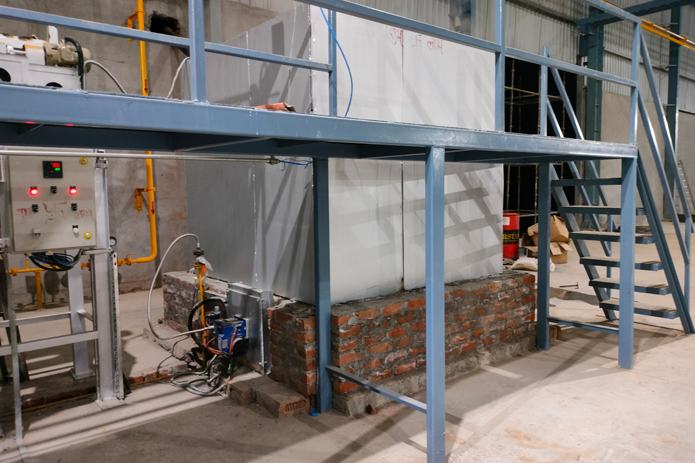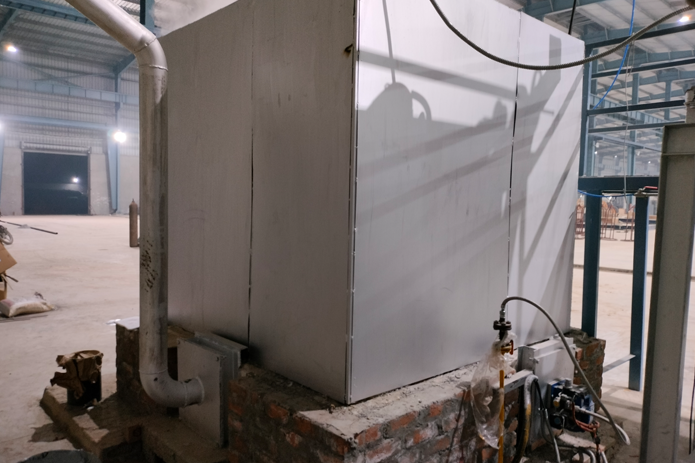

A coating tank is a container used in industrial processes for applying coatings or finishes onto various materials, such as metals, plastics or textiles. These tanks are often designed with features that facilitate the application of coatings evenly and efficiently. They may include mechanisms for controlling temperature, pressure and viscosity of the coating material.
DE (short for Diatomaceous Earth) coating tank is a specialized type of coating tank used in certain industries, particularly in filtration processes. Diatomaceous Earth is an organic sedimentary rock abundant in silica, naturally occurring in a pliable form. It easily disintegrates into a fine powder with hues ranging from white to off-white. It is often used as a filtration aid, particularly in water treatment and beverage processing. In a DE coating tank, the Diatomaceous Earth material is mixed with water or another liquid medium to form a slurry. This slurry is then applied onto the surface of filtration elements or other substrates to create a fine, porous layer that aids in filtration processes. The coating tank in this context would be designed specifically to handle the mixing, application and curing (if necessary) of the DE slurry onto the intended surfaces.
Overall, coating tanks and DE coating tanks serve essential roles in various industrial processes, providing the means to apply coatings or functional layers onto surfaces for a range of purposes, from protection to filtration.
Use of Coating & DE Coating Tank:
Coating and de-coating tanks are commonly used in various industries including manufacturing, automotive, aerospace and electronics among others. These tanks serve specific purposes in the surface treatment processes of materials.
Purpose: A coating tank is used to apply a protective or decorative layer onto the surface of objects or materials. This coating can serve various purposes, including corrosion resistance, improved aesthetics, increased durability or enhanced functionality.
Applications:Painting: Coating tanks are often used in painting processes to apply paints, varnishes or other liquid coatings onto surfaces.
Electroplating: In electroplating processes, coating tanks are utilized to deposit a layer of metal onto a substrate using an electrolytic process.
Powder Coating: For powder coating applications, objects are dipped into a tank containing a powder coating material which adheres to the surface electrostatically.
Chemical Coating: Various chemical coatings, such as anti-corrosion coatings or protective coatings can be applied using coating tanks.
Purpose: A de-coating tank is used to remove existing coatings or residues from the surface of objects or materials. This process is necessary when reworking or refurbishing coated components or when recycling materials.
Applications:Stripping:De-coating tanks are used to strip off existing paint, varnish, or other coatings from surfaces preparing them for re-coating or further processing.
Cleaning: These tanks can also be used for cleaning parts by removing residues, contaminants or unwanted layers from surfaces.
Surface Preparation: De-coating tanks are often employed as a preliminary step before applying new coatings to ensure proper adhesion and surface quality.
Both coating and de-coating tanks are integral parts of surface treatment processes, contributing to the quality, durability, and functionality of coated products. They play crucial roles in industries where surface finishing is essential for product performance, appearance, and longevity. Proper maintenance and operation of these tanks are essential to ensure consistent and high-quality coating results while minimizing waste and environmental impact.
Coating & DE Coating Tank application industries:Coating and de-coating tanks find applications in various industries where surface treatment, protection or alteration of materials is necessary.
Some common industries where these tanks are used include:
1.Automotive: Coating tanks are utilized for applying protective coatings to automotive parts such as car bodies, chassis and engine components. De-coating tanks are used to remove old coatings for rework or recycling purposes.
2.Aerospace: Aircraft parts often require specialized coatings for corrosion protection, thermal insulation or aerodynamic performance. Coating tanks are used for applying these coatings while de-coating tanks are used for maintenance, repair and overhaul (MRO) operations.
3.Metal Finishing: Industries involved in metal fabrication, such as steel mills, metal stamping and metal casting facilities, use coating tanks to apply surface treatments like galvanizing, anodizing or electroplating to enhance corrosion resistance or aesthetics.
4.Electronics: Coating tanks are employed in electronics manufacturing for applying protective coatings to circuit boards, electronic components and assemblies to improve their performance and reliability, especially in harsh environments.
5.Medical Devices: Coating tanks are used in the medical industry for applying biocompatible coatings to medical implants, devices and instruments to improve their longevity and compatibility with the human body.
6.Chemical Processing: Industries involved in chemical processing utilize coating tanks for applying protective coatings to tanks, pipes and equipment to prevent corrosion and contamination. De-coating tanks may also be used for equipment maintenance and refurbishment.
7.Textile: Textile industries use coating tanks for applying coatings to fabrics for waterproofing, flame resistance or decorative purposes.
8.Packaging: Coating tanks are used in the packaging industry for applying coatings to paper, cardboard and plastic materials to enhance their barrier properties, printability, and appearance.
9.Renewable Energy: Coating tanks are utilized in the production of solar panels and wind turbine components for applying protective coatings to increase durability and performance in outdoor environments.
10.Construction: Coating tanks are used in the construction industry for applying protective coatings to structural steel, concrete surfaces, and infrastructure components to improve durability and resistance to environmental factors such as corrosion, weathering, and chemical exposure.
| Technical Specifications | ||
|---|---|---|
| Type | Batch Type | |
| Charge Material | Stainless Steel Wire Coil. | |
| Charge Capacity | App. 500 Kg - 1000 Kgs / batch max. | |
| Tank Capacity | Appx. 3000- 5000 Ltrs | |
| No. of coil to be processed | One at a time | |
| Processing Time Per Coil | App. 20 Minutes. | |
| Fuel | L.P.G. & P.N.G | |
| Tank Temperature | 80° - 85° (90°C max.) | |
| Mode of Temp. control | Automatic through Temperature controller (On/Off type) | |
| Mode of Charging / Discharge | Manual by over head crane, Customer scope | |